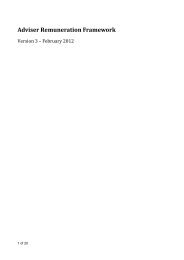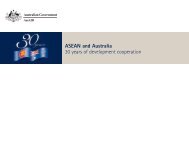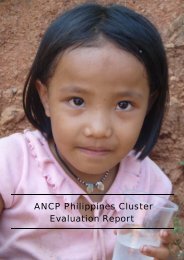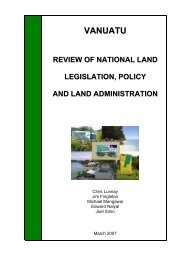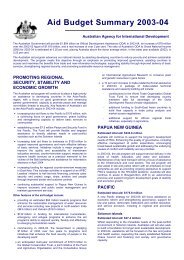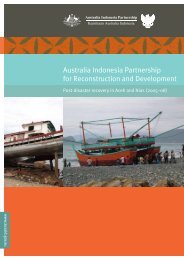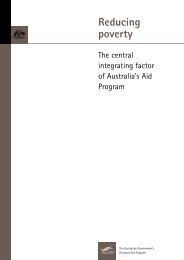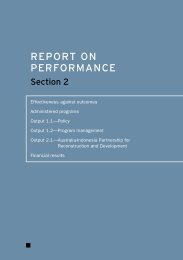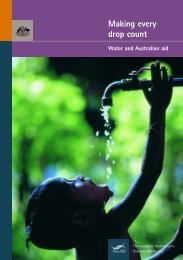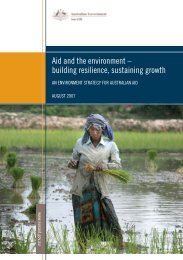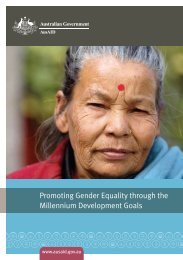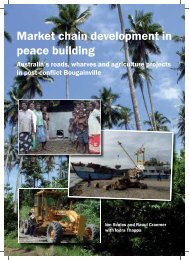Australian Aid to PNG - AusAID
Australian Aid to PNG - AusAID
Australian Aid to PNG - AusAID
Create successful ePaper yourself
Turn your PDF publications into a flip-book with our unique Google optimized e-Paper software.
4.4 Involving Other DonorsPapua New Guinea, more than most developing countries, has consistentlyrelied on a single donor – Australia – for its development assistance financing.Until 1982, <strong>Australian</strong> budget support alone accounted for some 95% of theforeign grants received by Papua New Guinea. 14 By 1987–88, it still accountedfor 80% of Papua New Guinea’s <strong>to</strong>tal aid receipts. 15 At that time, in tandemwith the fundamental shift in the nature of the aid relationship that had beenagreed by the two governments, it was envisaged that other donors wouldgradually start <strong>to</strong> play an increasing role in Papua New Guinea’s development.Papua New Guinea invited the World Bank <strong>to</strong> establish a Consultative Group,and the inaugural meeting held in May 1988 succeeded in achieving broaderinternational support for Papua New Guinea’s development strategies. Althoughsubsequent meetings of the Consultative Group have stimulated an expansionand diversification of the country’s aid sources, Papua New Guinea <strong>to</strong>dayremains heavily reliant on <strong>Australian</strong> aid, which currently accounts for about72% of its <strong>to</strong>tal bilateral aid. Japan is the next largest bilateral aid donor.Multilateral institutions such as the Asian Development Bank (ADB), the WorldBank, the United Nations (UN), and the European Union (EU) also providesubstantial support.External resources can best assist economic growth, poverty alleviation andbroad development if domestic economic policies in the recipient country aresupportive. Accordingly, <strong>AusAID</strong> has devoted considerable resources <strong>to</strong> researchand analysis <strong>to</strong> strengthen the policy dialogue between Australia and PapuaNew Guinea, particularly since 1990. It was the first <strong>Australian</strong> bilateral aidprogram <strong>to</strong> invest heavily in policy research and analysis, an initiative intended<strong>to</strong> provide practical support for the changing nature of the developmentpartnership between the two countries articulated in the 1987 Joint Declarationof Principles. These analytical reports are still regarded as the best informationproduced internationally in relation <strong>to</strong> Papua New Guinea, and wereinstrumental in engaging other donors in Papua New Guinea’s development.These efforts <strong>to</strong> broaden Papua New Guinea’s base of external finance andadvice have lost momentum in recent years. The last Consultative Groupmeeting was held in November 1999. This has been unfortunate, coincidingwith a period in Papua New Guinea’s development when the country hasprobably most needed the coordinated support of a cohesive body of donors.The independent aid policy priorities and programming and delivery processesof each donor (including Australia) have added <strong>to</strong> the complexity of aid14 Desk Study: Papua New Guinea (Literature Review), <strong>AusAID</strong>, May 1984.15 Australia’s Overseas <strong>Aid</strong> Program 1987–88, Budget Related Paper No. 4, <strong>Australian</strong> Government PublishingService, 1987.30 The Contribution of <strong>Australian</strong> <strong>Aid</strong> <strong>to</strong> Papua New Guinea’s Development 1975–2000



